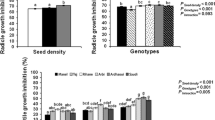Abstract
Wild oat plants may produce toxic substances that suppress the growth and development of desirable species, thus accounting for severe yield loss in infested fields. The purpose of this study was to determine the allelopathic potential of wild oat (Avena fatua) on the growth of spring wheat (Triticum aestivum var. Fieldwin) in the absence of plant competition. Wild oat and spring wheat plants were grown separately in 250-ml beakers in a sand medium. Root exudates were extracted from wild oat medium at the 1-, 2-, 3-, and 4-leaf stages of wild oat development and added to beakers containing spring wheat in temporally corresponding stages of development. Spring wheat root and leaf dry weights were measured to determine if one or more allelochemical agents were released from wild oat roots. Spring wheat leaf and root dry weights were significantly reduced by exudates from wild oat plants at the 2- and 4-leaf stages of development, respectively. Allelochemicals were isolated from wild oat root exudates at various stages of plant development. Paper chromatography analysis indicated that at least two unknown compounds were present.R f values in benzene-acetic acid-water of the two unknown compounds (0.825 and 0.930) were similar to scopoletin (7-hydroxy-6-methoxycoumarin) and vanillic acid (4-hydroxy-3-methoxybenzoic acid), respectively. Additional tests using diazotizedp-nitraniline, ultraviolet absorption spectra, and gas chromatography analysis also indicated that the unknowns were coumarin-related compounds such as scopoletin and vanillic acid.
Similar content being viewed by others
References
Banting, J. D. 1974. Growth habit and control of wild oats.Can. Dep. Agric. Publ. 1531, Ottawa, p. 36.
Bell, A.R., andNalewaja, J.D. 1968. Competition of wild oat in wheat and barley.Weed Sci. 16:505–508.
Block, R.J. 1952. Paper Chromatography: A Laboratory Manual. Academic Press, New York, p. 127.
Chancellor, R.J., andPeters, N.C.B. 1976, Competition between wild oats and crops, pp. 99–112,in D.P. Jones (ed.). Wild Oats in World Agriculture. Agriculture Research Council, London.
Coleman-Harrell, M.E. 1978. Influence of densities and exposure durations of wild oat (Avena fatua L.) population on the yields of spring wheat (Triticum aeslivum L.) MS thesis, University of Idaho, Moscow, p. 69.
Fay, P.K., andDuke, W.B. 1977. An assessment of the allelopathic potential inAvena germplasm.Weed Sci. 25:224–228.
Guenzi, W.D., andMcCalla, T.M. 1966. Phenolic acids in oats, wheat, sorghum, and corn residues and their phytotoxicity.Agron. J. 58:303–304.
Hoaglund, P.R., andAron, D.I. 1950. The water culture method of growing plants without soil.Calif. Agric. Exp. Stn. Clrc. 347.
Kirk, T.K., andAdler, E. 1970. Methoxyl-deficient structural elements in lignin of sweetgum decayed by brown-rot fungus.Acta Chem. Scand. 24:3379–3390.
Lee, G.A., Thill, D.C., andSchumacher, W.J. 1981. Wild oat cultural control.Current Information Series No. 584, University of Idaho, Moscow.
Martin, P. 1957. The secretion of organic compounds, especially scopoletin, from roots of oat seedlings.Z. Bot. 45:475–506.
Martin, P. andRademacker, B. 1960. Studies on the mutual effects of weeds and crops.Br. Ecol. Soc. Symp. 1:143–152.
Molisch, H. 1937. Der Einfluss einer Pflanz auf die audere—Allelopathic. Fisher, Jena.
Nalewaja, J.D. 1974. Wild oat losses in the United States. Report on wild oat workshop. Weed Science Society of America, pp. 23–29.
Swain, T. 1953. The identification of coumarins and related compounds by filter paper Chromatography.Biochem J. 53:200–208.
Tinnin, R.O.,andMuller, C.H. 1971. The allelopathic potential ofAvena fatua: Influence on herb distribution.Bull Torrey Bot. Club 98:243–250.
Tinnin, R.O., andMuller, C.H. 1972. The allelopathic influence ofAvena fatua: The allelopathic mechanism.Bull. Torrey Bot. Club 99:287–292.
Author information
Authors and Affiliations
Additional information
Received for publication September 12, 1982; Univ. of Idaho, Agric. Exp. Stn., Journal Paper No. 82719.
Rights and permissions
About this article
Cite this article
Schumacher, W.J., Thill, D.C. & Lee, G.A. Allelopathic potential of wild oat (Avena fatua) on spring wheat (Triticum aestivum) growth. J Chem Ecol 9, 1235–1245 (1983). https://doi.org/10.1007/BF00982225
Received:
Revised:
Issue Date:
DOI: https://doi.org/10.1007/BF00982225




